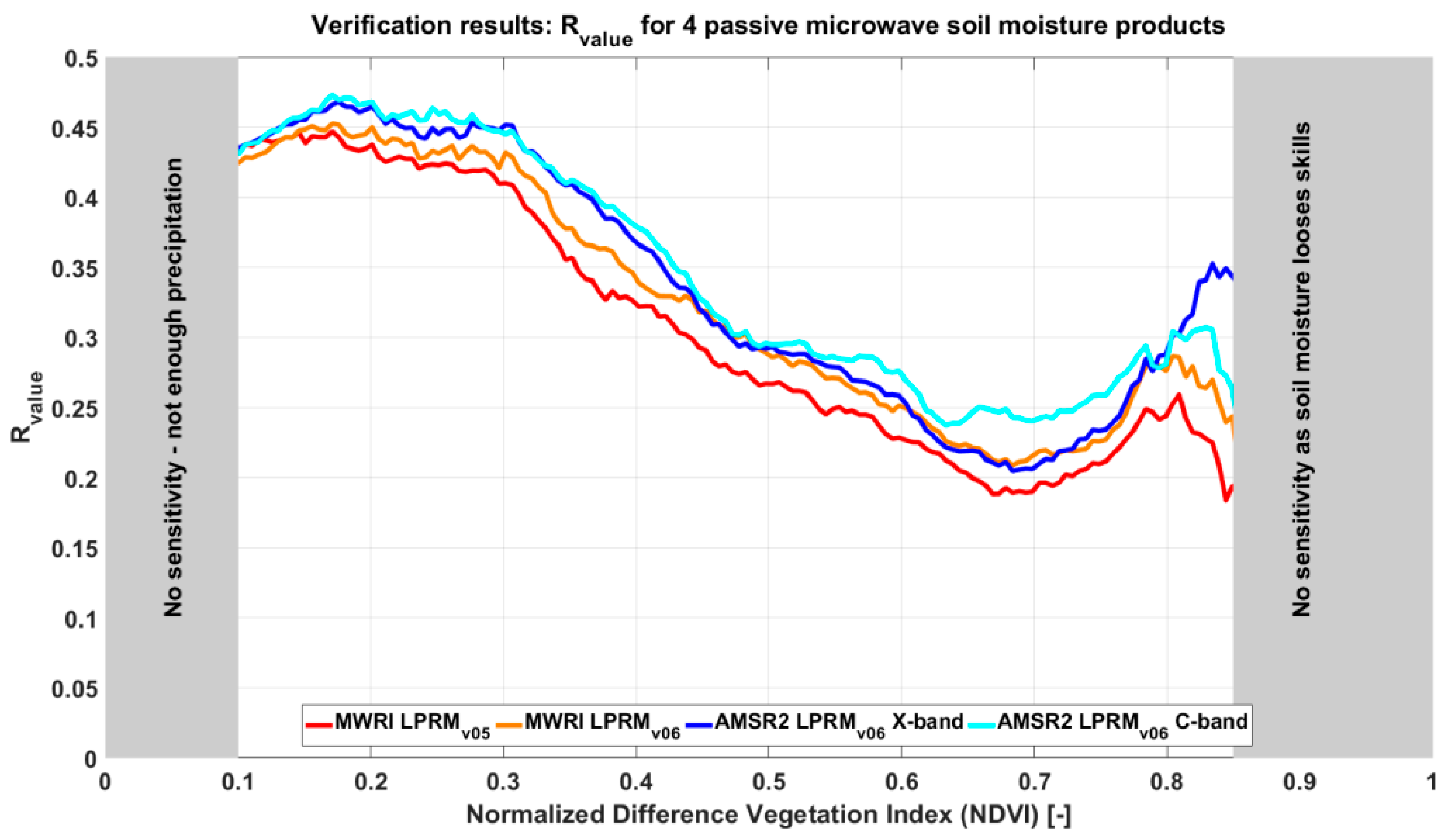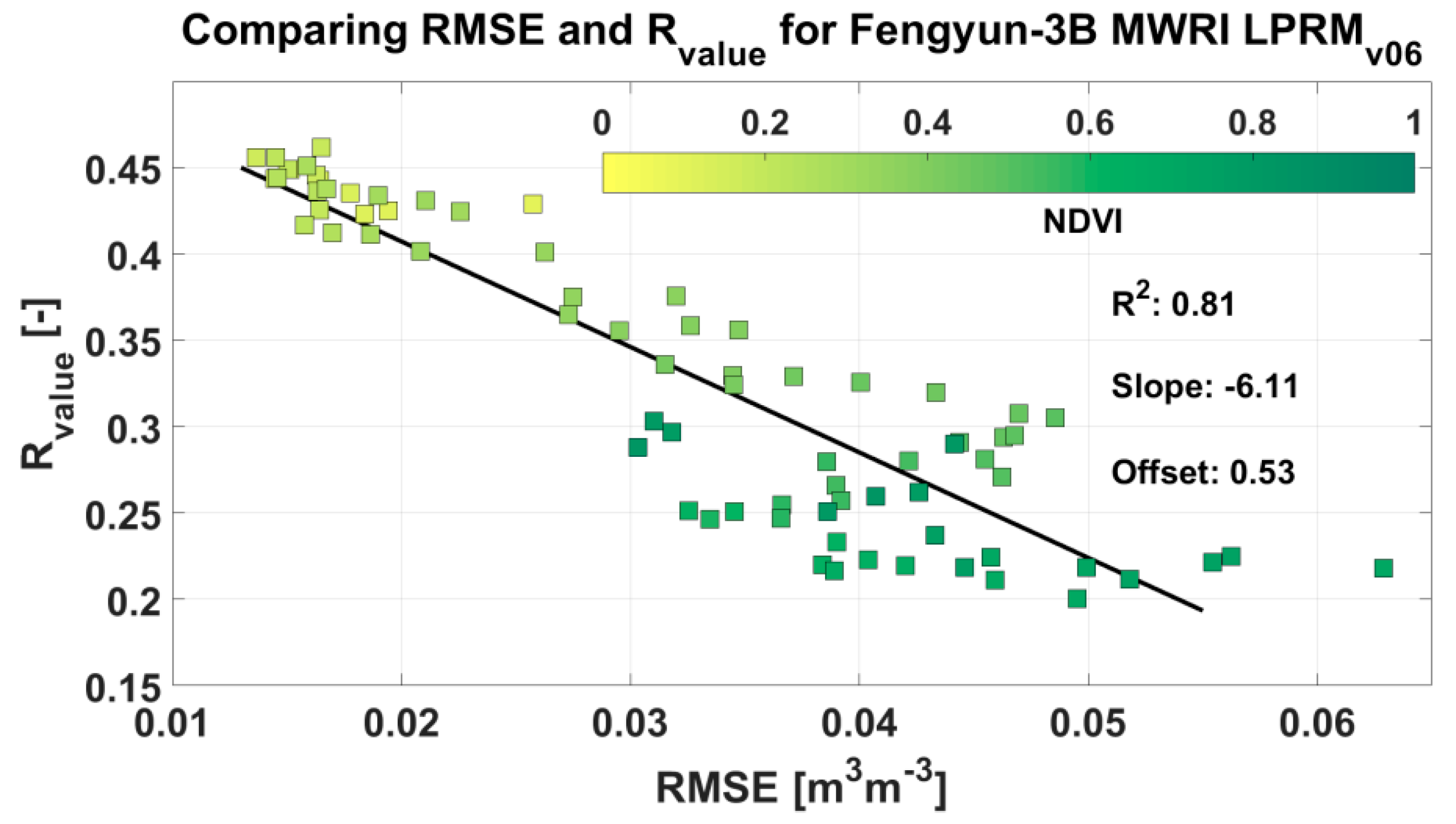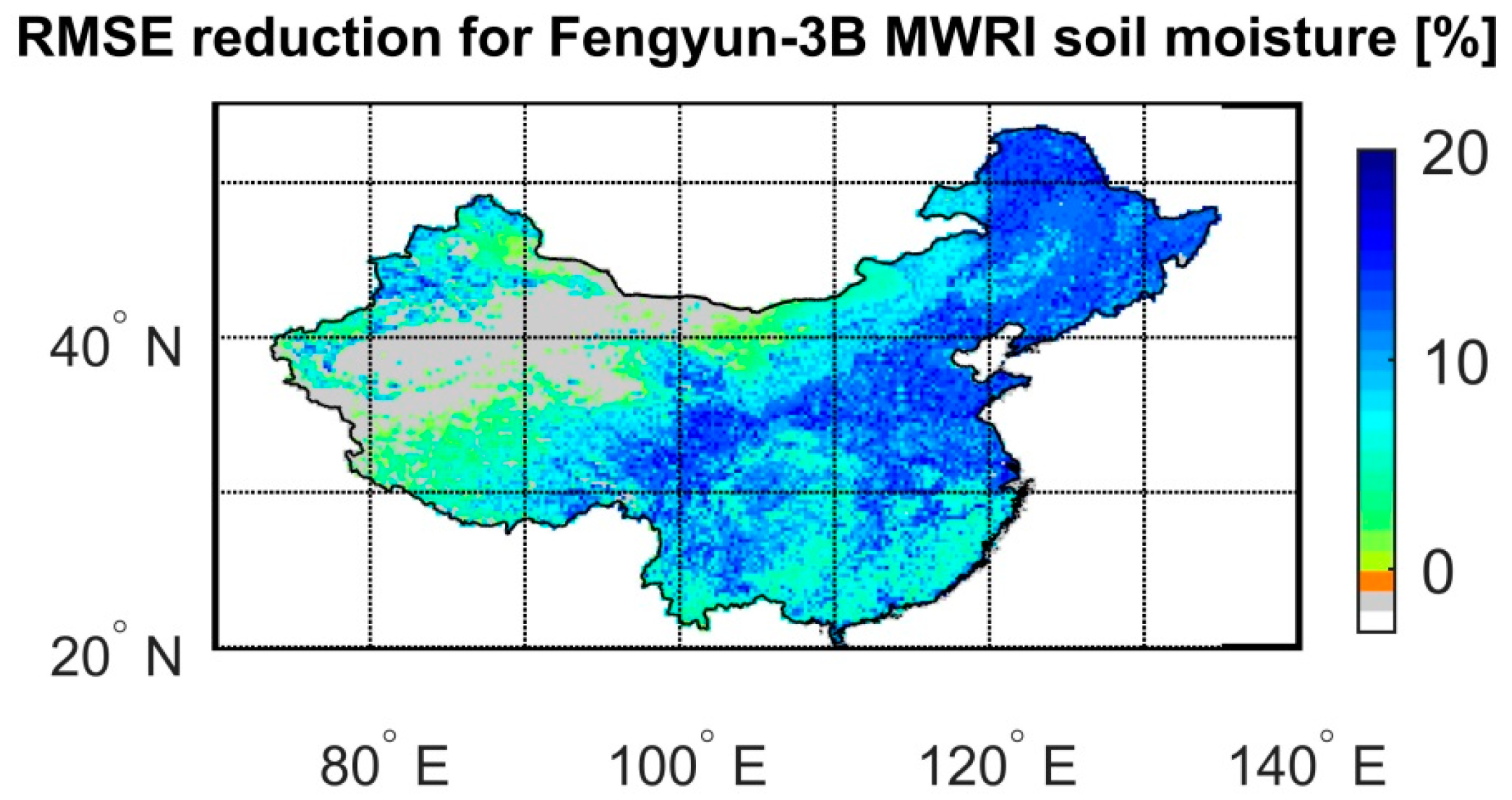The Evaluation of Single-Sensor Surface Soil Moisture Anomalies over the Mainland of the People’s Republic of China
Abstract
:1. Introduction
2. Materials and Methods
2.1. Passive Microwave Sensors
2.1.1. Fengyun-3B MWRI
2.1.2. GCOM-W AMSR2
2.1.3. SMOS MIRAS
2.2. Passive Microwave Retrieval Algorithms
2.2.1. The Land Parameter Retrieval Model
2.2.2. The L-Band Microwave Emission of the Biosphere
2.3. Additional Data Sources
2.3.1. MetOp-ASCAT and the Change Detection Algorithm
2.3.2. Re-Analysis Surface Soil Moisture from MERRA-2
2.3.3. Precipitation
2.3.4. Normalized Difference Vegetation Index
2.4. Data Pre-Processing
3. Methodology
3.1. The Triple Collocation Technique
3.2. The Rvalue Technique
4. Results
5. Discussion
6. Conclusions
Acknowledgments
Author Contributions
Conflicts of Interest
Abbreviations
| SMOS | Soil Moisture and Ocean Salinity |
| ESA | European Space Agency |
| AMSR2 | Advanced Microwave Scanning Radiometer |
| JAXA | Japan Aerospace Exploration Agency |
| MWRI | Microwave Radiation Imager |
| NSMC | National Satellite Meteorological Centre |
| LPRM | Land Parameter Retrieval Model |
| ECV | Essential Climate Variable |
| AMSR-E | Advanced Microwave Scanning Radiometer for Earth Observing System |
| NASA | National Aeronautics Space Administration |
| RFI | Radio Frequency Interference |
| GCOM-W | Global Change Observation Mission on Water |
| MIRAS | Microwave Imaging Radiometer using Aperture Synthesis |
| ASCAT | Advanced Scatterometer |
| L-MEB | L-band Microwave Emission of the Biosphere |
| EUMETSAT | European Organization for the Exploitation of Meteorological Satellites |
| MERRA | Modern Era Retrospective-analysis for Research and Applications |
| TRMM | Tropical Rainfall Monitoring Mission |
| NDVI | Normalized Vegetation Difference Index |
| RMSE | Root Mean Square Error |
References
- Wagner, W.; Lemoine, G.; Rott, H. A method for estimating soil moisture from ERS scatterometer and soil data. Remote Sens. Environ. 1999, 70, 191–207. [Google Scholar] [CrossRef]
- Njoku, E.; Jackson, T.; Lakshmi, V.; Chan, T.; Nghiem, S. Soil moisture retrieval from AMSR-E. IEEE Trans. Geosci. Remote Sens. 2003, 41, 215–229. [Google Scholar] [CrossRef]
- Miralles, D.G.; Van Den Berg, M.J.; Gash, J.H.; Parinussa, R.M.; De Jeu, R.A.; Beck, H.E.; Holmes, T.R.; Jiménez, C.; Verhoest, N.E.; Dorigo, W.A.; et al. El Niño-La Niña cycle and recent trends in continental evaporation. Nat. Clim. Chang. 2014, 4, 122–126. [Google Scholar] [CrossRef]
- Wanders, N.; Karssenberg, D.; de Roo, A.; de Jong, S.; Bierkens, M. The suitability of remotely sensed soil moisture for improving operational flood forecasting. Hydrol. Earth Syst. Sci. 2014, 18, 2343–2357. [Google Scholar] [CrossRef]
- Bolten, J.; Crow, W. Improved prediction of quasi global vegetation conditions using remotely sensed surface soil moisture. Geophys. Res. Lett. 2012, 39, L19406. [Google Scholar] [CrossRef]
- Taylor, C.; de Jeu, R.; Guichard, F.; Harris, P.; Dorigo, W. Afternoon rain more likely over drier soils. Nature 2012, 489, 423–426. [Google Scholar] [CrossRef] [PubMed] [Green Version]
- Guillod, B.; Orlowsky, B.; Miralles, D.; Teuling, A.; Seneviratne, S. Reconciling spatial and temporal soil moisture effects on afternoon rainfall. Nat. Commun. 2015. [Google Scholar] [CrossRef] [PubMed] [Green Version]
- Global Climate Observing System. Implementation Plan for the Global Observing System for Climate in Support of the UNFCCC; Global Climate Observing System: Geneva, Switzerland, 2010. [Google Scholar]
- Dorigo, W.; Wagner, W.; Albergel, C.; Albrecht, F.; Balsamo, G.; Brocca, L.; Chung, D.; Ertl, M.; Forkel, M.; Gruber, A.; et al. ESA CCI soil moisture for improved Earth system understanding: State-of-the art and future directions. Remote Sens. Environ. 2017. in review. [Google Scholar]
- Kerr, Y.; Waldteufel, P.; Wigneron, J.-P.; Delwart, S.; Cabot, F.; Boutin, J.; Escorihuela, M.; Font, J.; Reul, N.; Gruhier, C.; et al. The SMOS mission: New tool for monitoring key elements of the global water cycle. Proc. IEEE 2010, 98, 666–687. [Google Scholar] [CrossRef] [Green Version]
- Owe, M.; de Jeu, R.; Holmes, T. Multisensor historical climatology of satellite-derived global land surface moisture. J. Geophys. Res. 2008, 113, 1–17. [Google Scholar] [CrossRef]
- Mladenova, I.; Jackson, T.; Njoku, E.; Bindlish, R.; Chan, S.; Cosh, M.; Holmes, T.; de Jeu, R.; Jones, L.; Kimball, J. Remote monitoring of soil moisture using passive microwave-based techniques—Theoretical basis and overview of selected algorithms for AMSR-E. Remote Sens. Environ. 2014, 144, 197–213. [Google Scholar] [CrossRef]
- Zhang, P.; Yang, J.; Dong, C.; Lu, N.; Yang, Z.; Shi, J. General introduction on payloads, ground segment and data application of Fengyun 3A. Front. Earth Sci. 2009, 3, 367–373. [Google Scholar] [CrossRef]
- Parinussa, R.; Wang, G.; Holmes, T.; Liu, Y.; Dolman, A.; de Jeu, R.; Jiang, T.; Zhang, P.; Shi, J. Global surface soil moisture from the microwave radiation imager onboard the Fengyun-3B satellite. Int. J. Remote Sens. 2014, 35, 7007–7029. [Google Scholar] [CrossRef]
- Parinussa, R.; Meesters, A.; Liu, Y.; Dorigo, W.; Wagner, W.; de Jeu, R. Error estimates for near-real-time satellite soil moisture as derived from the Land Parameter Retrieval Model. IEEE Geosci. Remote Sens. Lett. 2011, 8, 779–783. [Google Scholar] [CrossRef]
- Schmugge, T. Remote sensing of soil moisture: Recent advances. IEEE Trans. Geosci. Remote Sens. 1983, 21, 336–344. [Google Scholar] [CrossRef]
- Li, L.; Njoku, E.; Im, E.; Chang, P.; St. German, K. A preliminary survey of radio-frequency interference over the U.S. in Aqua AMSR-E data. IEEE Trans. Geosci. Remote Sens. 2004, 42, 380–390. [Google Scholar] [CrossRef]
- Oliva, R.; Daganzo, E.; Kerr, Y.; Mecklenburg, S.; Nieto, S.; Richaume, P.; Gruhier, C. SMOS radio frequency interference scenario: Status and actions taken to improve the RFI environment in the 1400–1427-MHz passive band. IEEE Trans. Geosci. Remote Sens. 2012, 50, 1427–1439. [Google Scholar] [CrossRef] [Green Version]
- De Nijs, A.; Parinussa, R.; de Jeu, R.; Schellekens, J.; Holmes, T. A methodology to determine radio frequency interference in AMSR2 observations. IEEE Trans. Geosci. Remote Sens. 2015, 53, 5148–5159. [Google Scholar] [CrossRef]
- Holmes, T.; de Jeu, R.; Owe, M.; Dolman, A. Land surface temperature from KA band (37 GHz) passive microwave observations. J. Geophys. Res. 2009, 114, 1–15. [Google Scholar] [CrossRef]
- Corbella, I.; Torres, F.; Duffo, N.; Gonzalez-Gambau, V.; Pablos, M.; Martin-Neira, M. MIRAS Calibration and performance: results from the SMOS in-orbit commissioning phase. IEEE Trans. Geosci. Remote Sens. 2011, 49, 3147–3155. [Google Scholar] [CrossRef]
- Van der Schalie, R.; de Jeu, R.; Kerr, Y.; Wigneron, J.-P.; Rodriguez Fernandez, N.; Al-Yaari, A.; Parinussa, R.; Mecklenburg, S.; Drusch, M. Towards the merging of radiative transfer based soil moisture data from SMOS and AMSR-E. Remote Sens. Environ. 2017, 189, 180–193. [Google Scholar] [CrossRef]
- Van der Schalie, R.; Kerr, Y.; Wigneron, J.-P.; Rodriguez-Fernandez, N.; Al-Yaari, A.; de Jeu, R. Global SMOS soil moisture retrievals from the land parameter retrieval model. Int. J. Appl. Earth Obs. Geoinf. 2016, 45, 125–134. [Google Scholar] [CrossRef]
- Meesters, A.; de Jeu, R.; Owe, M. Analytical derivation of the vegetation optical depth from the microwave polarization difference index. IEEE Geosci. Remote Sens. Lett. 2005, 2, 121–123. [Google Scholar] [CrossRef]
- De Jeu, R.; Wagner, W.; Holmes, T.; Dolman, A.; van de Giesen, N.; Friesen, J. Global soil moisture patterns observed by space borne microwave radiometers and scatterometers. Surv. Geophys. 2008, 29, 399–420. [Google Scholar] [CrossRef] [Green Version]
- Parinussa, R.; Holmes, T.; de Jeu, R. Soil moisture retrievals from the WindSat spaceborne polarimetric microwave radiometer. IEEE Trans. Geosci. Remote Sens. 2012, 50, 2683–2694. [Google Scholar] [CrossRef]
- Parinussa, R.; de Jeu, R.; van der Schalie, R.; Crow, W.; Lei, F.; Holmes, T. A quasi-global approach to improve satellite surface soil moisture anomalies through the land surface temperature input. Climate 2016. [Google Scholar] [CrossRef]
- Liu, Y.; Parinussa, R.; Dorigo, W.; de Jeu, R.; Wagner, W.; van Dijk, A.; McCabe, M.; Evans, J. Developing an improved soil moisture dataset by blending passive and active microwave satellite-based retrievals. Hydrol. Earth Syst. Sci. 2011, 15, 426–436. [Google Scholar] [CrossRef] [Green Version]
- Dorigo, W.; Scipal, K.; Parinussa, R.; Liu, Y.; Wagner, W.; de Jeu, R.; Naeimi, V. Error characterization of global active and passive microwave soil moisture datasets. Hydrol. Earth Syst. Sci. 2010, 14, 2605–2616. [Google Scholar] [CrossRef] [Green Version]
- Mo, T.; Choudhury, B.; Schmugge, T.; Wang, J.; Jackson, T. A model for microwave emission from vegetation-covered fields. J. Geophys. Res. 1982, 87, 11229–11237. [Google Scholar] [CrossRef]
- Löw, A.; Stacke, T.; Dorigo, W.; de Jeu, R.; Hagemann, S. Potential and limitations of multidecadal satellite soil moisture observations for selected climate model evaluation studies. Hydrol. Earth Syst. Sci. 2013, 17, 3523–3542. [Google Scholar] [CrossRef]
- Wigneron, J.-P.; Kerr, Y.; Waldteufel, P.; Saleh, K.; Escorihuela, M.; Richaume, P.; Ferrazzoli, P.; De Rosnay, P.; Gurney, R.; Calvet, J.C. L-band Microwave Emission of the Biosphere (L-MEB) model: Description and calibration against experimental datasets over crop fields. Remote Sens. Environ. 2007, 107, 639–655. [Google Scholar] [CrossRef]
- Van de Griend, A.; Wigneron, J.P. On the measurement of microwave vegetation properties: Some guidelines for a protocol. IEEE Trans. Geosci. Remote Sens. 2004, 42, 2277–2289. [Google Scholar] [CrossRef]
- Lei, F.; Crow, W.; Shen, H.; Parinussa, R.; Holmes, T. The impact of local acquisition time on the accuracy of microwave surface soil moisture retrievals over the Contiguous United States. Remote Sens. 2015, 7, 13448–13465. [Google Scholar] [CrossRef]
- Naeimi, V.; Scipal, K.; Bartalis, Z.; Hasenauer, S.; Wagner, W. An improved soil moisture retrieval algorithm for ERS and METOP scatterometer observations. IEEE Trans. Geosci. Remote Sens. 2009, 47, 1999–2013. [Google Scholar] [CrossRef]
- Al-Yaai, A.; Wigneron, J.-P.; Ducharme, A.; Kerr, Y.H.; Wagner, W.; de Lannoy, G.; Reichle, R.; Al Bitar, A.; Dorigo, W.; Richaume, P.; Mialon, A. Global-scale comparison of passive (SMOS) and active (ASCAT) satellite based microwave soil moisture retrievals with soil moisture simulations (MERRA-Land). Remote Sens. Environ. 2014, 152, 614–626. [Google Scholar] [CrossRef] [Green Version]
- Crow, W.; Miralles, D.; Cosh, M. A quasi-global evaluation system for satellite based surface soil moisture retrievals. IEEE Trans. Geosci. Remote Sens. 2010, 48, 2516–2527. [Google Scholar] [CrossRef]
- Parinussa, R.; Holmes, T.; Yilmaz, T.; Crow, W. The impact of land surface temperature on soil moisture anomaly detection from passive microwave observations. Hydrol. Earth Syst. Sci. 2011, 15, 3135–3151. [Google Scholar] [CrossRef]
- Huffman, G.; Adler, R.; Bolvin, D.; Gu, G.; Nelkin, E.; Bowman, K.; Hong, Y.; Stocker, E.; Wolff, D. The TRMM Multisatellite Precipitation Analysis (TMPA): Quasi-global, multiyear, combined-sensor precipitation estimates at fine scales. J. Hydrometeorol. 2007, 8, 38–55. [Google Scholar] [CrossRef]
- Reichle, R.; Koster, R. Bias reduction in short records of satellite soil moisture. Geophys. Res. Lett. 2004. [Google Scholar] [CrossRef]
- Brocca, L.; Hasenauer, S.; Lacava, T.; Melone, F.; Moramarco, T.; Wagner, W.; Dorigo, W.; Matgen, P.; Martinez-Fernandez, J.; Llorens, P. Soil moisture estimation through ASCAT and AMSR-E sensors: An intercomparison and validation study across Europe. Remote Sens. Environ. 2011, 155, 3390–3408. [Google Scholar] [CrossRef]
- Miralles, D.; Crow, W.; Cosh, M. Estimating spatial sampling errors in coarse-scale soil moisture estimates derived from point-scale observations. J. Hydrometeorol. 2010, 11, 1423–1429. [Google Scholar] [CrossRef]
- Crow, W.; Zhan, X. Continental-scale evaluation of remotely sensed soil moisture products. IEEE Geosci. Remote Sens. Lett. 2007, 4, 451–455. [Google Scholar] [CrossRef]
- Crow, W.; Wagner, W.; Naeimi, V. The impact of radar incidence angle on soil moisture retrieval skill. IEEE Geosci. Remote Sens. Lett. 2010, 7, 501–505. [Google Scholar] [CrossRef]
- Zwieback, S.; Dorigo, W.; Wagner, W. Estimation of the temporal autocorrelation structure by the collocation technique with emphasis on soil moisture studies. Hydrol. Sci. J. 2013, 58, 1729–1747. [Google Scholar] [CrossRef]







| Characteristics | Fengyun-3B MWRI | GCOM-W AMSR2 | SMOS MIRAS | MetOp ASCAT |
|---|---|---|---|---|
| Low frequency | 10.65 GHz | 6.9 & 10.65 GHz | 1.4 GHz | 5.3 GHz |
| Bandwidth | 0.18 GHz | 0.35 & 0.10 GHz | 0.20 GHz | N/A |
| Sensor accuracy | 0.5 K | 0.3 K & 0.6 K | 2–5 K | 0.50 dB |
| Polarization | H and V all frequencies | H and V all frequencies | H and V all incidence angles | H and V all frequencies |
| Incidence angle(s) | 55.4° | 55° | Multiple | 25°–65° |
| Sample size footprint | 51 km × 85 km | 35 km × 62 km24 km × 42 km | 23–350 km | 25 km × 50 km |
| Altitude | 836 km | 700 km | 760 km | 837 km |
| Swath width | 1400 km | 1445 km | 1000 km | 2 x 550 km |
| Orbit type | Polar | Polar | Polar | Polar |
| Ascending orbit | 01:30 pm | 01:30 pm | 06:00 am | 09.30 pm |
| Descending orbit | 01:30 am | 01:30 am | 06:00 pm | 09.30 am |
| Data period used | January 2012 to December 2015 | July 2012 to December 2015 | January 2012 to December 2015 | January 2012 to December 2015 |
| Product Combination | Number | Satellite Sensor | Path Overpass Time | Algorithm Version | Frequency | Explicit Focus of Comparison |
|---|---|---|---|---|---|---|
| 1 | Fengyun-3B MWRI | Descending 01:30 am | LPRMv05 | X-band 10.7 GHz | ||
| A | LPRM algorithm version comparison | |||||
| 2 | Fengyun-3B MWRI | Descending 01:30 am | LPRMv06 | X-band 10.7 GHz | ||
| B | Passive microwave radiometer comparison | |||||
| 3 | GCOM-W AMSR2 | Descending 01:30 am | LPRMv06 | X-band 10.7 GHz | ||
| C | Passive microwave frequency comparison | |||||
| 4 | GCOM-W AMSR2 | Descending 01:30 am | LPRMv06 | C-band 6.9 GHz | ||
| D | Passive microwave radiometer & frequency comparison | |||||
| 5 | SMOS MIRAS | Ascending 06:00 am | LPRMv06 | L-band 1.4 GHz | ||
| E | SMOS algorithm comparison | |||||
| 6 | SMOS MIRAS | Ascending 06:00 am | L-MEB | L-band 1.4 GHz | ||
© 2017 by the authors. Licensee MDPI, Basel, Switzerland. This article is an open access article distributed under the terms and conditions of the Creative Commons Attribution (CC BY) license ( http://creativecommons.org/licenses/by/4.0/).
Share and Cite
Parinussa, R.M.; Wang, G.; Liu, Y.Y.; Hagan, D.F.T.; Lin, F.; Van der Schalie, R.; De Jeu, R.A.M. The Evaluation of Single-Sensor Surface Soil Moisture Anomalies over the Mainland of the People’s Republic of China. Remote Sens. 2017, 9, 149. https://doi.org/10.3390/rs9020149
Parinussa RM, Wang G, Liu YY, Hagan DFT, Lin F, Van der Schalie R, De Jeu RAM. The Evaluation of Single-Sensor Surface Soil Moisture Anomalies over the Mainland of the People’s Republic of China. Remote Sensing. 2017; 9(2):149. https://doi.org/10.3390/rs9020149
Chicago/Turabian StyleParinussa, Robert M., Guojie Wang, Yi Y. Liu, Daniel F. T. Hagan, Fenfang Lin, Robin Van der Schalie, and Richard A. M. De Jeu. 2017. "The Evaluation of Single-Sensor Surface Soil Moisture Anomalies over the Mainland of the People’s Republic of China" Remote Sensing 9, no. 2: 149. https://doi.org/10.3390/rs9020149







